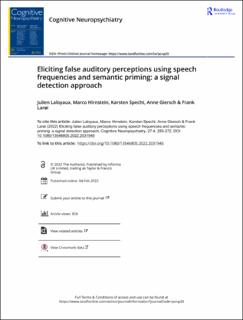| dc.contributor.author | Laloyaux, Julien | |
| dc.contributor.author | Hirnstein, Marco | |
| dc.contributor.author | Specht, Karsten | |
| dc.contributor.author | Giersch, Anne | |
| dc.contributor.author | Larøi, Frank | |
| dc.date.accessioned | 2022-08-05T13:26:15Z | |
| dc.date.available | 2022-08-05T13:26:15Z | |
| dc.date.created | 2022-05-19T11:01:18Z | |
| dc.date.issued | 2022 | |
| dc.identifier.issn | 1354-6805 | |
| dc.identifier.uri | https://hdl.handle.net/11250/3010398 | |
| dc.description.abstract | Introduction
Individuals experiencing auditory hallucinations (AH) tend to perceive voices when exposed to random noise. However, the factors driving this tendency remain unclear. The present study examined the interaction of a top-down (expectations) and bottom-up (type of noise) process to better understand the mechanisms that underlie AH.
Methods
Fifty-two healthy individuals (29 with high proneness and 23 with low proneness to AH) completed a signal detection task, in which they listened to pre-recorded sentences. The last word was either masked by noise or only noise was presented without the word. Two types of noise existed (speech-related versus speech-unrelated frequencies) and words were characterised by either high or low levels of semantic expectation.
Results
Participants with high proneness to AH showed a more liberal decision bias (i.e., they were more likely to report having heard a word) and poorer discrimination ability as compared to participants with low proneness to AH – but only when the word was masked by speech-related noises and the level of expectation was high. Further, the more liberal decision bias correlated negatively with the tendency to experience AH.
Conclusion
This novel paradigm demonstrated an interaction between top-down (level of expectation) and bottom-up (type of noise) processes, supporting current theoretical models of AH. | en_US |
| dc.language.iso | eng | en_US |
| dc.publisher | Taylor & Francis | en_US |
| dc.rights | Attribution-NonCommercial-NoDerivatives 4.0 Internasjonal | * |
| dc.rights.uri | http://creativecommons.org/licenses/by-nc-nd/4.0/deed.no | * |
| dc.title | Eliciting false auditory perceptions using speech frequencies and semantic priming: a signal detection approach | en_US |
| dc.type | Journal article | en_US |
| dc.type | Peer reviewed | en_US |
| dc.description.version | publishedVersion | en_US |
| dc.rights.holder | Copyright 2022 The Author(s) | en_US |
| cristin.ispublished | true | |
| cristin.fulltext | original | |
| cristin.qualitycode | 1 | |
| dc.identifier.doi | 10.1080/13546805.2022.2031945 | |
| dc.identifier.cristin | 2025518 | |
| dc.source.journal | Cognitive Neuropsychiatry | en_US |
| dc.source.pagenumber | 255-272 | en_US |
| dc.identifier.citation | Cognitive Neuropsychiatry. 2022, 27 (4), 255-272. | en_US |
| dc.source.volume | 27 | en_US |
| dc.source.issue | 4 | en_US |

